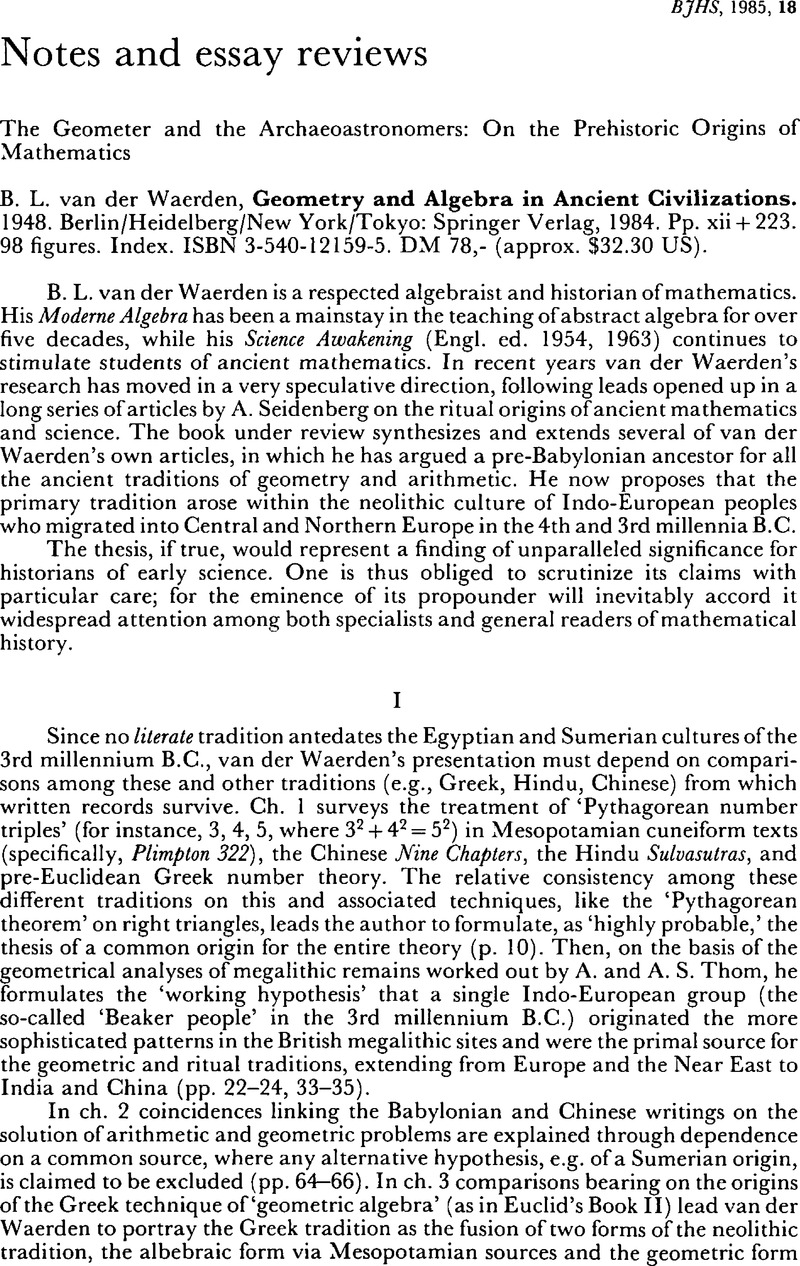Article contents
The Geometer and the Archaeoastronomers: On the Prehistoric Origins of Mathematics
Published online by Cambridge University Press: 05 January 2009
Abstract

- Type
- Notes and Essay Reviews
- Information
- Copyright
- Copyright © British Society for the History of Science 1985
References
1 Note, further, that a Mesopotamian scribe working out the root of 133; 20 by the formula would obtain 11; 33, 38, and this would yield the converted value 11 + 1/2+ 1/16, that is, 11 + 1/2 plus the remainder;3, 38. In fraction tables, the nearest approximation to that remainder would be 1/16 =; 3, 45.
2 Van der Waerden's principal source on neolithic studies is Wood, J. E., Sun, Moon, and Standing Stones, Oxford, 1978Google Scholar, although he also cites works by , A. and Thom, A. S. and MacKie, E. (cf. p. 16)Google Scholar. For a distinguished survey of the field, one may consult Heggie, D. C., Megalithic Science: Ancient Mathematics and Astronomy in North-West Europe, London, 1981Google Scholar. Heggie's careful attention to the statistical subtleties of analyzing the data and his serious consideration of alternative hypotheses for explaining them give reassurance that the claims of the devotees have received ample technical scrutiny.
3 Among the many studies of the megaliths by A., and Thom, A. S., I cite only their monograph, ‘Megalithic Rings,’ BAR British Series, 81, 1980Google Scholar; this work provides the groundplans and measurements of 229 sites and includes an ample bibliography of studies by Thom, A. and Burl, A. (pp. 11–13)Google Scholar. The Thoms provide a resume of their findings in the essay, ‘Rings and Menhirs: Geometry and Astronomy in the Neolithic Age,’ in the anthology, In Search of Ancient Astronomies, ed. Krupp, E. C., New York, 1977, ch. 2Google Scholar. For a more popularized and fully sympathetic account of archaeoastronomy in relation principally to British sites one may consult Wood, J. E., Sun, Moon and Standing Stones, Oxford, 1978.Google Scholar
4 Cf. ‘Rings and Menhirs,’ in Krupp, (ed.), In Search, pp. 45–53.Google Scholar
5 A very impressive discussion of alternative reconstructions is given by Angell, I. O. in his essays ‘Megalithic Mathematics, Ancient Almanacs or Neolithic Nonsense,’ Bulletin of the Institute of Mathematics and its Applications, 1978, 14, pp. 253–258Google Scholar and ‘Stone Circles: Megalithic Mathematics or Neolithic Nonsense?’ Mathematical Gazette, 1976, 60, pp. 189–193Google Scholar. He sustains the sceptical position, so clearly marked in his titles, by developing simpler reconstructions which fit the data of the monuments as well as do those of the Thoms. Thus, he concludes that neither his theory nor theirs can presume to describe with certainty the procedures actually followed by the neolithic builders. I am endebted to D. T. Whiteside for these and other references relating to the discussion of the Thoms' proposals.
6 The sequence as given by Wood is 39·7, 61·8, 80·5, 104·9, 139·2, 162·1; cf. Sun, Moon and Standing Stones, p. 52.Google Scholar
7 The role of ‘goodness of fit’ as a discriminator among hypotheses on the plans of the megaliths is likewise disputed by Heggie, D. C., who presents a comprehensive critique in his Megalithic Science, London, 1981, pp. 72–77.Google Scholar
8 Heggie provides a detailed overview of the statistical evidence and analytic methods relating to the debate over the ‘megalithic yard;’ cf. Megalithic Science, ch. 3. In his judgment, measurement by use of physical units based on the human body, e.g. by pacing, provides a more plausible interpretation of the data than does the Thoms' hypothesis of use of a more accurate standardized unit. Heggie's survey makes evident the concomitant stimulus that the debate has provided for the development of statistical tests to distinguish between random and nonrandom sets of data. For a brief discussion, effecting a middle position between the Thoms and their critics, see Wood, , op. cit., pp. 54–56.)Google Scholar
9 Sun, , Moon and Standing Stones, p. 36.Google Scholar
- 1
- Cited by




